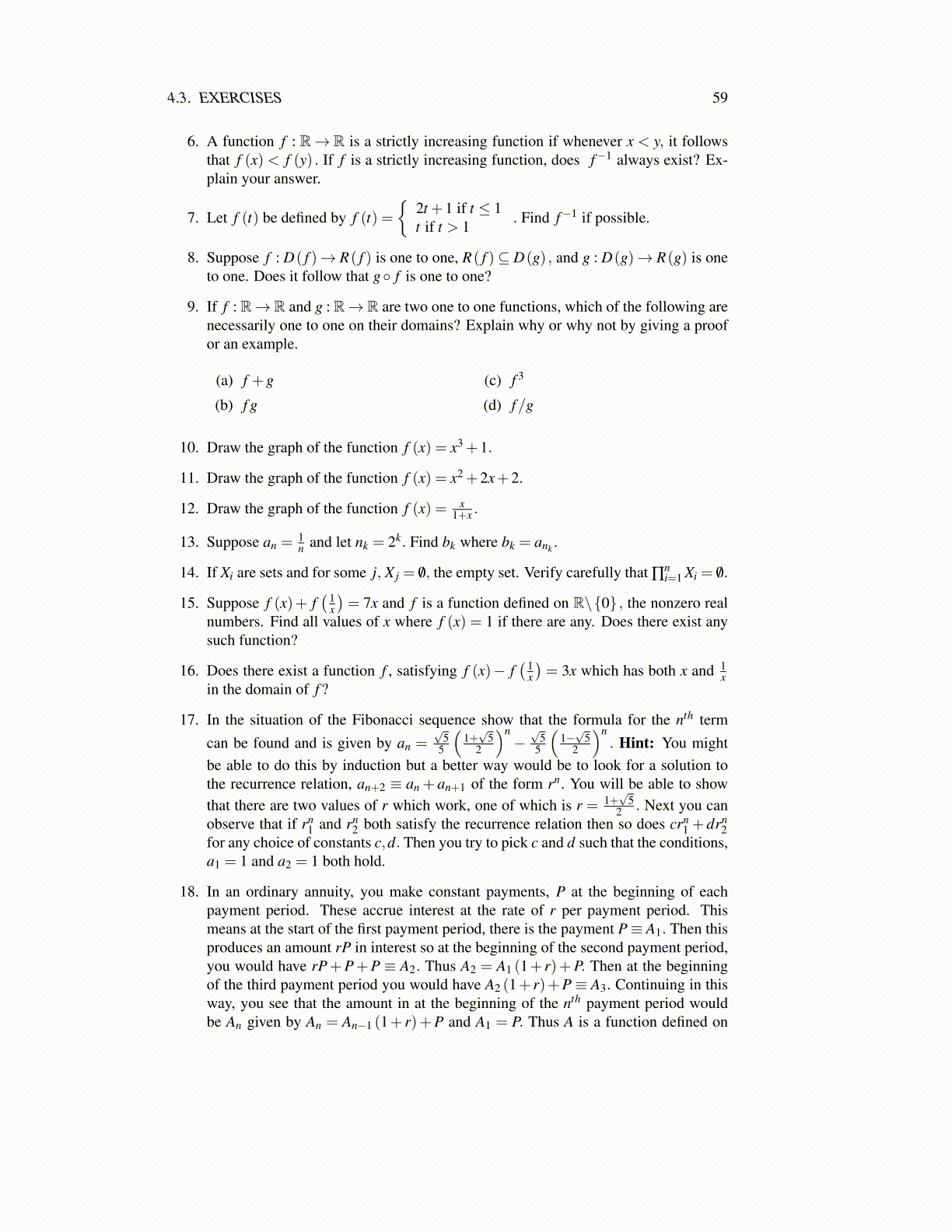
4.4. THE LIMIT OF A SEQUENCE 59
F× ·· ·×F where F consists of real or complex numbers and, although other definitionsare used,
∥a∥ ≡max{|ai| : i≤ p}for a = (a1, · · · ,ap) ∈ Fp. In this book, it is usually the case that p = 1, but there is nodifficulty in considering a more general case.
Proposition 4.4.2 The usual properties of absolute value hold for ∥·∥ with addition ofthe vectors, and multiplication by a scalar α, as presented in elementary calculus
a+b≡ (a1 +b1, · · · ,ap +bp) , αa≡ (αa1, · · · ,αap)
Proof: From the triangle inequality for complex numbers,
∥a+b∥ ≡max{|ai +bi| , i≤ p} ≤max{|ai| , i≤ p}+max{|bi| , i≤ p}= ∥a∥+∥b∥ .(4.2)
Also, for α ∈ F, ∥αa∥ ≡ max{|αai| : i≤ p} = |α|max{|ai| : i≤ p} = |α|∥a∥. By defi-nition, ∥a∥ ≥ 0 and is 0 if and only if ai = 0 for each i if and only if a = 0 ≡ (0, · · · ,0) .Also ∥a∥ = ∥a−b+b∥ ≤ ∥a−b∥+ ∥b∥ so ∥a∥−∥b∥ ≤ ∥a−b∥ . Similarly ∥b∥−∥a∥ ≤∥b−a∥= ∥a−b∥ and so |∥a∥−∥b∥| ≤ ∥a−b∥.
In words the definition says that given any measure of closeness ε, the terms of thesequence are eventually this close to a. Here, the word “eventually” refers to n being suffi-ciently large. The above definition is always the definition of what is meant by the limit ofa sequence.
Proposition 4.4.3 Let an =(an
1, · · · ,anp). Then an → a if and only if for each i ≤ p,
ani → ai.
Proof:⇒ is obvious because |ani −ai| ≤ ∥an−a∥.
⇐ There exists ni such that∣∣ak
i −ai∣∣< ε whenever k > ni. Let
N ≥max{ni : i≤ p}
Then for n≥ N,∥an−a∥ ≡max{|ani −ai| , i≤ p}< ε .
Theorem 4.4.4 If limn→∞ an = a and limn→∞ an = â then â = a.
Proof: Suppose â ̸= a. Then let 0 < ε < ∥â−a∥/2 in the definition of the limit. Itfollows there exists nε such that if n≥ nε , then ∥an−a∥< ε and ∥an− â∥< ε. Therefore,for such n, ∥â−a∥ ≤ ∥â−an∥+∥an−a∥< ε + ε < ∥â−a∥/2+∥â−a∥/2 = ∥â−a∥, acontradiction.
Example 4.4.5 Let an =(
1n2+1 ,
in
)∈ F2.
Then it seems clear that limn→∞ an = (0,0) . In fact, this is true from the definition.Let ε > 0 be given. Let nε ≥ max
(√ε−1, 1
ε
). Then if n > nε ≥
√ε−1, it follows that
n2 +1 > ε−1 and so 0 < 1n2+1 = an < ε and also n≥ 1/ε so 1/n < ε . Thus ∥an− (0,0)∥ ≡
max(∣∣∣ 1
n2+1 −0∣∣∣ , ∣∣ i
n −0∣∣)< ε whenever n is this large.
Note the definition was of no use in finding a candidate for the limit. This had to beproduced based on other considerations. The definition is for verifying beyond any doubtthat something is the limit. It is also what must be referred to in establishing theoremswhich are good for finding limits.